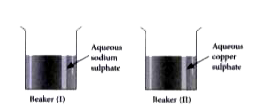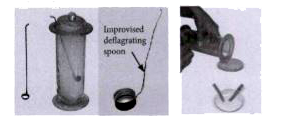Magnesium powder was added to two different salt solutions in beakers (I) and (II) as shown in the given figures. Answer the questions that follow:

What would you observe when magnesium powder is added to beaker (II)? Explain your answer.
Blue colour of the solution will change and solution will become colourless and brown deposits are seen. This is because, magnesium is more reactive than copper hence, it can displace copper from its solution.
Topper's Solved these Questions
- FOOTSTEPS towards(CBSE Board)BOOK - MTG IIT JEE FOUNDATIONCHAPTER - FOOTSTEPS towards(CBSE Board)EXERCISE - SECTION - C
11 Videos
- FOOTSTEPS TOWARDS (NEET)BOOK - MTG IIT JEE FOUNDATIONCHAPTER - FOOTSTEPS TOWARDS (NEET)EXERCISE - Multiple Choice Question
45 Videos
- MATERIALS : METALS AND NON-METALSBOOK - MTG IIT JEE FOUNDATIONCHAPTER - MATERIALS : METALS AND NON-METALSEXERCISE - Olympiad/HOTS Corner
20 Videos
Similar Questions
Magnesium powder was added to two different salt solutions in beakers (I) and (II) as shown in the given figures. Answer the questions that follow:

Write an equation for the reaction that takes place.
View SolutionMagnesium powder was added to two different salt solutions in beakers (I) and (II) as shown in the given figures. Answer the questions that follow:

What can you deduce about the order of reactivity of the three metals? Write the order.
View Solution
Knowledge Check
Reema took 5 ml of Lead Nitrate solution in a beaker and added approximately 4 ml of Potassium lodide solution to it. What would she observe?
AThe solution turned red.BYellow precipitate was formedCWhite precipitate was formed.DThe reaction mixture became hot.
Look at the figure shown and answer the following questions :

What change would you observe in the calcium hydroxide solution taken in test tube B?
View SolutionObserve the given figure and answer the following question :
What is the type of reaction involved ?
View SolutionReema took 5ml of Lead Nitrate solution in a beaker and added approximately 4ml of Potassium Iodide solution to it. What would she observe?
View SolutionSamples of four metals A, B, C and D were taken and were added to the following solutions one by one.
The results obtained have been tabulated as follows :
MetalSolution to which metal is addedIron(II) sulphateCopper(II) sulphateZince sulphateSilver nitrateANo reactionDisplacement __ __BDisplacement __No reaction __CNo reactionNo reactionNo reactionDisplacementDNo reactionNo reactionNo reactionNo reaction
Use the table given above to answer the following questions :
(a) Which is the most reactive metal ?
(b) What would you observe when B is added to solution of copper(II) sulphate ?
(c ) Arrange the metals A, B, C and D in order of increasing reactivity.
View SolutionObserve the given figure which shows burning of sulphur powder and answer the questions that follow:

Write the reactions involved.
View SolutionObserve the given figure which shows burning of sulphur powder and answer the questions that follow:

What colour changes do you observe in red and blue litmus papers? What does it indicate about nature of the solution - acidic or basic?
View SolutionPrachi took 50 mL of water in two beakers at room temperature and added sodium chloride to one beaker while sugar to the other, till no more solute would dissolve. Then she heated the contents of the beakers and added more solutes in them.
(a) Will the amount of salt and sugar that can be dissolved in water at given temperature same ?
(b) What will you expect to happen if she cools the contents of the beakers ? Justify your answer.
View Solution
